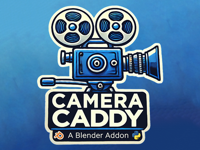- Camera Caddy - User Manual
- Camera Caddy - FAQ
- Features Walkthrough: video
- Installation Tutorial: video

User Manual
Overview
Welcome to the Camera Caddy User Manual! This document provides comprehensive instructions on how to install, configure, and use Camera Caddy — a Blender addon designed to simplify camera management in your 3D projects.
Works with Blender versions 2.8 to 4.2.
Table of Contents
- Installation
- Accessing Camera Caddy
- Adding a Camera
- Managing Cameras
- Animating Cameras
- Adjusting Camera Settings
- Tips & Best Practices
- Support
Installation
Installation Tutorial: video
-
Download the Add-On:
- Purchase and download Camera Caddy from Blender Market
-
Installation instructions for Blender 2.8 to 4.1:
- Open Blender and go to Edit > Preferences > Add-ons.
- In the top right corner, click on the Install an add-on button.
- Navigate to the camera_caddy_v1.zip file, select it, and click Install Add-on.
- Once installed, enable Camera Caddy by checking the Enable add-on box next to its name.
-
Installation instructions for Blender 4.2:
- Open Blender and go to Edit > Preferences > Extensions.
- Click the dropdown menu in the top right hand corner and scroll down to select Install from disk.
- Navigate to the camera_caddy_v2.zip file, select it, and click Install Add-on.
- Once installed, Camera Caddy should be enabled by default.
- If Camera Caddy is not enabled, go to the Add-ons section in your preferences and check the Enable add-on box next to its name to enable it.
-
Save Preferences:
- Click Save Preferences to ensure Camera Caddy is available every time you start Blender.
Accessing Camera Caddy
Features Walkthrough: video
- Open Blender and go to the 3D Viewport.
- Press "N" to open the "N-Panel" on the right side of the viewport.
- You will find Camera Caddy listed as a tab in the N-Panel.
Adding a Camera
-
Position the Viewport:
- Move your viewport to the desired angle where you want the camera to be placed.
-
Add a New Camera:
- In the Camera Caddy panel, click the Add Camera button.
-
A pop-up menu will appear, allowing you to:
- Name your camera
- Set the Focal Length
- Set the F-Stop
- After setting your preferences, the camera will be added to a collection called "Cameras", set as the active camera and camera view will be toggled on.
Managing Cameras
Active Camera Overview
The active camera is automatically displayed in the Camera Caddy panel. This overview allows you to quickly see and manage which camera is currently active.
Switching Between Cameras
-
Open the Camera Switching Dropdown:
- In the Camera Caddy panel, click the Camera Switching Dropdown.
- You’ll see a list of all available cameras in your scene.
-
Switch Cameras:
- Click on any camera in the list to make it the active camera.
- The active camera is highlighted with a green icon.
Deleting Cameras
-
Delete a Non-Active Camera:
- In the Camera Switching Dropdown, click the Trashcan icon next to any non-active camera to delete it from your scene.
Animating Cameras
Setting Up Animated Camera Transitions
-
Bind a Camera to the Timeline:
- In the Camera Switching Dropdown, click the Film icon next to the active camera.
- A pop-up menu will appear, allowing you to select a frame on the timeline, by default the current frame will be selected.
- Once selected, a marker with the camera's name will be placed on the timeline at that frame.
Managing Camera Markers
-
Move Camera Markers:
- Select the marker on the timeline and drag it to the desired frame.
-
Delete Camera Markers:
- Select the marker, press X, and confirm the deletion.
-
Preview Shots:
- Set up markers at specific intervals to preview different camera angles efficiently, this can make for quick camera view renders by setting each camera at 1 frame intervals, then render animation for only those frames.
Adjusting Camera Settings
Transform Controls
-
Adjust Location and Rotation:
- Use the Transform controls in the Camera Caddy panel to adjust the camera’s XYZ location and rotation.
-
Lock Camera to View:
- Click the Lock Camera to View button to dynamically reposition your camera as you move in the viewport.
- This option is automatically disabled when you switch cameras.
Depth of Field
-
Toggle Depth of Field:
- Click the Depth of Field button to turn depth of field on or off.
-
Focus Settings:
- Choose a specific object to focus on or set an exact focus distance.
Tips & Best Practices
- Descriptive Camera Names: Always name your cameras descriptively to easily manage them in complex scenes.
- Use Markers: When animating, use timeline markers to keep track of camera transitions.
- Preview Before Rendering: Set up preview shots using one-frame intervals to quickly assess different angles.
Support
If you encounter any issues or need further assistance, please refer to the following resources:
- Contact Support
- Frequently Asked Questions
- Features Walkthrough: video
- Installation Tutorial: video
Thank you for choosing Camera Caddy! We hope it enhances your Blender experience.
This manual is structured to provide clear, step-by-step instructions on using Camera Caddy, ensuring that users can easily access and utilize all of its features.
